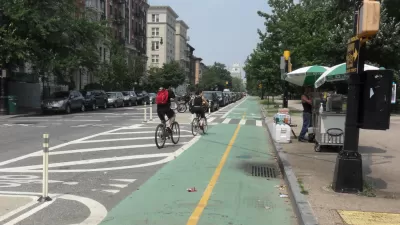Shaun Courtney examines the current politics surrounding gentrification and bicycling throughout the country and what planners can do to address the issue.

Shaun Courtney of Urbanful discusses the relationship between gentrification and bicycling in many American cities today. Although intended to be a safe designation of space for cyclists amid vehicular traffic, bike lane plans have caused controversy due to their perception as a step toward gentrification.
Alex Wilson, the executive director of the nonprofit West Town Bikes / Ciclo Urbano in Chicago said, "sometimes I think [bike] education and encouragement doesn’t get a fair shake. The city needs to think about the folks who will actually use all these new bike lanes. They should consider, how much is this a plan for pavement and how much is it a plan for people?" in a recent post on Grid Chicago.
Courtney believes that cities must remove the perception that bike lanes getting built in a new neighborhood are intended to attract new-comers, and propose bike lanes instead of imposing bike lanes. One way to do this is to solicit input and adjust plans according to community buy-in, and stress that the benefits of bike lanes serve “all residents regardless of status: They reduce congestion, create a safer road environment, incentive healthy behavior and create access to jobs and economic centers.”
FULL STORY: Do bike lanes gentrify neighborhoods?

Planetizen Federal Action Tracker
A weekly monitor of how Trump’s orders and actions are impacting planners and planning in America.

Chicago’s Ghost Rails
Just beneath the surface of the modern city lie the remnants of its expansive early 20th-century streetcar system.

San Antonio and Austin are Fusing Into one Massive Megaregion
The region spanning the two central Texas cities is growing fast, posing challenges for local infrastructure and water supplies.

Since Zion's Shuttles Went Electric “The Smog is Gone”
Visitors to Zion National Park can enjoy the canyon via the nation’s first fully electric park shuttle system.

Trump Distributing DOT Safety Funds at 1/10 Rate of Biden
Funds for Safe Streets and other transportation safety and equity programs are being held up by administrative reviews and conflicts with the Trump administration’s priorities.

German Cities Subsidize Taxis for Women Amid Wave of Violence
Free or low-cost taxi rides can help women navigate cities more safely, but critics say the programs don't address the root causes of violence against women.
Urban Design for Planners 1: Software Tools
This six-course series explores essential urban design concepts using open source software and equips planners with the tools they need to participate fully in the urban design process.
Planning for Universal Design
Learn the tools for implementing Universal Design in planning regulations.
planning NEXT
Appalachian Highlands Housing Partners
Mpact (founded as Rail~Volution)
City of Camden Redevelopment Agency
City of Astoria
City of Portland
City of Laramie



























